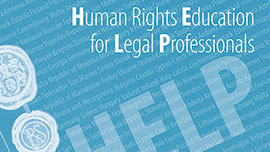Speech by Tatiana Termacic
The importance of harmonisation of national case law in the Council of Europe member States, Annual HELP Network Conference
Strasbourg, 16-17 June 2016
The former president of the European Court of Human Rights (ECtHR), Dean Spielmann, referred soundly to the margin of appreciation at a Conference in March 2014 when he said that it is “an incentive to the domestic judge to conduct the necessary Convention review, realising in this way the principle of subsidiarity”.
This message also reflects well the HELP philosophy on training for legal professionals, as well as the rationale of this year’s HELP Conference. In simple words, HELP’s objective is not to substitute to the national training institutions but to provide the necessary tools to allow them to fully achieve their mission.
This philosophy is also reflected throughout the new HELP Guidebook on Human Rights training methodology for Legal Professionals, which we are very proud to present you today.
You might think that it is a bit ambitious for HELP to lead the way towards national case law harmonisation. Actually it is not. HELP should be seen as one of the tools to ensure harmonisation at various levels through its tailor-made courses.
Harmonisation of judicial practice is certainly not a new concept for Council of Europe member states – in many of them there have been attempts to create harmonisation mechanisms in this or another form. The CoE is now providing a platform in which different models can be exposed and discussed.
When one speaks of harmonisation, one should immediately clarify that it is definitely not to be understood as uniformity. Indeed, the objective is not to impose any rigidity on the judge. On the contrary, the interpretation of the law and the case law of European and national courts gives him or her the liberty in his/her decision-making and it is an element of his/her independence. Therefore, efforts to harmonise case law at the national level should not be perceived as an inappropriate interference with judicial independence.
In this regard the role of national training institutions is particularly significant as they provide training based on the practices of national courts, hence their role to promote harmonised case law at national level even further.
Bringing coherence in the judicial practice at national level, whether it is with the Strasbourg case law or within a national judicial system, is crucial to ensure the greatest protection of human rights in our member states. Why is this so?
First, inconsistent application of national and European legal standards may result in a lack of legal certainty and lead to the unpredictability of the outcome of a dispute.
Of course, you well know that one of the fundamental aspects of the rule of law IS the principle of legal certainty. This was recalled in the Rule of Law Check-list recently adopted by the Venice Commission. Legal certainty requires, inter alia, that where the courts have finally determined an issue, their ruling should not be called into question. The same goes for applications for leave to appeal (Brumarescu v. Romania [GC], § 61). The power to give a binding decision which may not be altered by a non-judicial authority to the detriment of an individual party is inherent in the very notion of a “tribunal” (Van de Hurk v. the Netherlands, § 45).
A final decision may be called into question only when this is made necessary by circumstances of a substantial and compelling character such as a judicial error (Ryabykh v. Russia, § 52).
The objective of a court’s interpretation is to clarify the meaning of a legal norm or to expand its meaning according to the developments in a given society. In many cases, however, different interpretations offered by different courts in similar cases create confusion for the “end users” of the justice system – the parties to legal proceedings. The lack of harmonisation was also recognised as an obstacle to an efficient functioning of the judiciary as a whole (see, for example, the Venice Commission’s Opinion on Legal Certainty and the Independence of the Judiciary in Bosnia and Herzegovina, CDL-AD (2012)014-e).
A second challenge for legal professionals is related to the question: what is the law? As you all know, some rights under the Convention articles cannot be derogated from (such as the ban on torture and ill-treatment under Article 3). Most of rights, however, can be limited by the law as stated in the concerned provisions of the Convention (such as Articles 8 to 11).
The ECtHR reached the conclusion that the law shall not be limited only to the legislation (law in its formal sense). In addition to the enacted law (legislation), “the law” also includes the case law of national courts and in some cases and under very limited conditions established national practices of state authorities, (law in its substantive sense). In Kruslin v France for instance, the Court says that “in a sphere covered by the written law, the “law” is the enactment in force as the competent courts have interpreted it in the light, if necessary, of any new practical developments”.
In sum, the interference with a right under the Convention will have a legal basis in domestic law if it is reasonably stated either in the legislation or case law, or established domestic practices of governmental bodies, or in combination of those.
What is important is the requirement that this law in a broader sense must be sufficiently accessible, precise and foreseeable in its application, in order to avoid all risk of arbitrariness. The national training institutions and the Bar associations play an important role in making use of these interpreted norms in the training they deliver. Indeed, legal professionals, be it lawyers, judges or prosecutors must be enabled to transpose them into concrete situations.
This means that if the case law has not been published or the established practice of governmental agencies has not been made publicly known, those cannot account for “the law” which could limit human rights. Also, if the case law is unclear or if it is conflicting it does not account for “the law”.
That is why HELP seeks to contribute to harmonisation of judicial practice. What could HELP harmonise? First of all, HELP offers a harmonised training methodology on the ECHR and other related topics. This is done through the Guidebook which will be presented later on and also through the establishment of HELP certified trainers in each country. Through training these trainers, we ensure that they will deliver training on human rights in a harmonised way.
Secondly, HELP seeks to harmonise the content of the training itself, paying attention to pluralism and national specificities. While the master courses present the key and minimum standards (on the basis of a harmonised large-scale training needs assessment), the national versions of the courses address the specific needs and legal practices of the pilot countries. In this context, I am delighted to inform you that a new course on the reasoning of judgments will be ready by the autumn.
It is in everybody’s interest, particularly the victims of human rights violations, that human rights problems are solved at the domestic level preventing a costly and lengthy supranational litigation in Strasbourg. However, too often, such issues still arise before the Strasbourg Court despite the Court having ruled upon several times about the same issue in the same member state.
As an example of this discrepancy, look at the Amuur v. France judgment, involving the 22-day detention of an asylum-seeker in an airport transit zone - deemed arbitrary by the ECtHR on 25 June 1996. This judgment did not prevent other cases raising very similar legal issues from reaching Strasbourg and the Court finding a violation in similar cases also against other countries. Unfortunately, new identical cases arrive to Strasbourg following the current refugee crisis. This example shows that training of judges, prosecutors and lawyers is necessary to ensure some coherence in the way the Strasbourg case law is applied in the member States.
Thirdly, HELP is also contributing to an increased dialogue among judges at national level, in the framework of courses on various topics. This dialogue among judges is essential to secure a more harmonised national judicial practice.
Our Division is currently implementing 25 bilateral projects on the national implementation of the ECHR in 13 countries, without taking into account HELP in the 28. The HELP methodology and tools are systematically used in the training components of these projects.
You already heard from Ambassador Kivi about the very good example of the Estonian Supreme Court which has developed a tool on Court Practice Analysis.
I would like to mention two other countries where good practices have been developed with a view to ensuring a better harmonisation of national judicial practice.
The creation in Bosnia and Herzegovina of so-called “harmonisation panels” can surely be seen as a successful endeavour. These panels are composed of members of the judiciary and act under the auspices of the self-governing judicial body, the High Judicial and Prosecutorial Council of BiH - HJPC. The panels prepare opinions and recommendations adopted by consensus, which are then published by the website of the HJPC. I am pleased to say that the panels were established in the framework of a project implemented by the CoE and funded by Norway. We will actually present the results of their work at an international forum next week in Sarajevo.
Another example of a fruitful model can be found in Serbia, where a mechanism of harmonisation of court practice between the four appellate courts was put in place, also in the framework of a Council of Europe project first funded by Norway and now by the HRTF. Quarterly meetings of the four appellate courts and the Supreme Court of Cassation (SSC) were set as a regular practice. It allowed the SCC to take a leading role in the harmonisation of court practice and its coherence with the Strasbourg case law. This judicial dialogue created a positive environment for guaranteeing the right to a fair trial within a reasonable time, which led to a drastic decrease in the number of applications brought before the Strasbourg Court. Apart from these quarterly meetings, an important element was the strengthening in each of the courts of the court practice departments, whose mandate and responsibilities were expanded.
A further area to explore could be how to enhance the dialogue with lawyers and prosecutors as well, to achieve further case law harmonisation.
As you know from the agenda, the discussions of one of the working groups will be fully dedicated to this topic and I sincerely hope that more good practices and ideas will come out of it. We will also have the opportunity to listen to Anna Austin, Deputy Jurisconsult of the ECtHR, on the way the Jurisconsult ensures the consistency of a specific case with the case law the Court. Last but not least, we should not forget about the dialogue between national courts and the Strasbourg Court because harmonisation is a two-way process that ultimately contributes to a better protection of human rights.
Ladies and gentlemen,
In conclusion, human rights training should give legal professionals, and especially judges, more clarity and certainty in the way they deliver judgments at national level, and the case law of the ECtHR is the music score that they should use. Ultimately, it is not uniform notes that we will hear but harmonious music that will appease the people of Europe.




